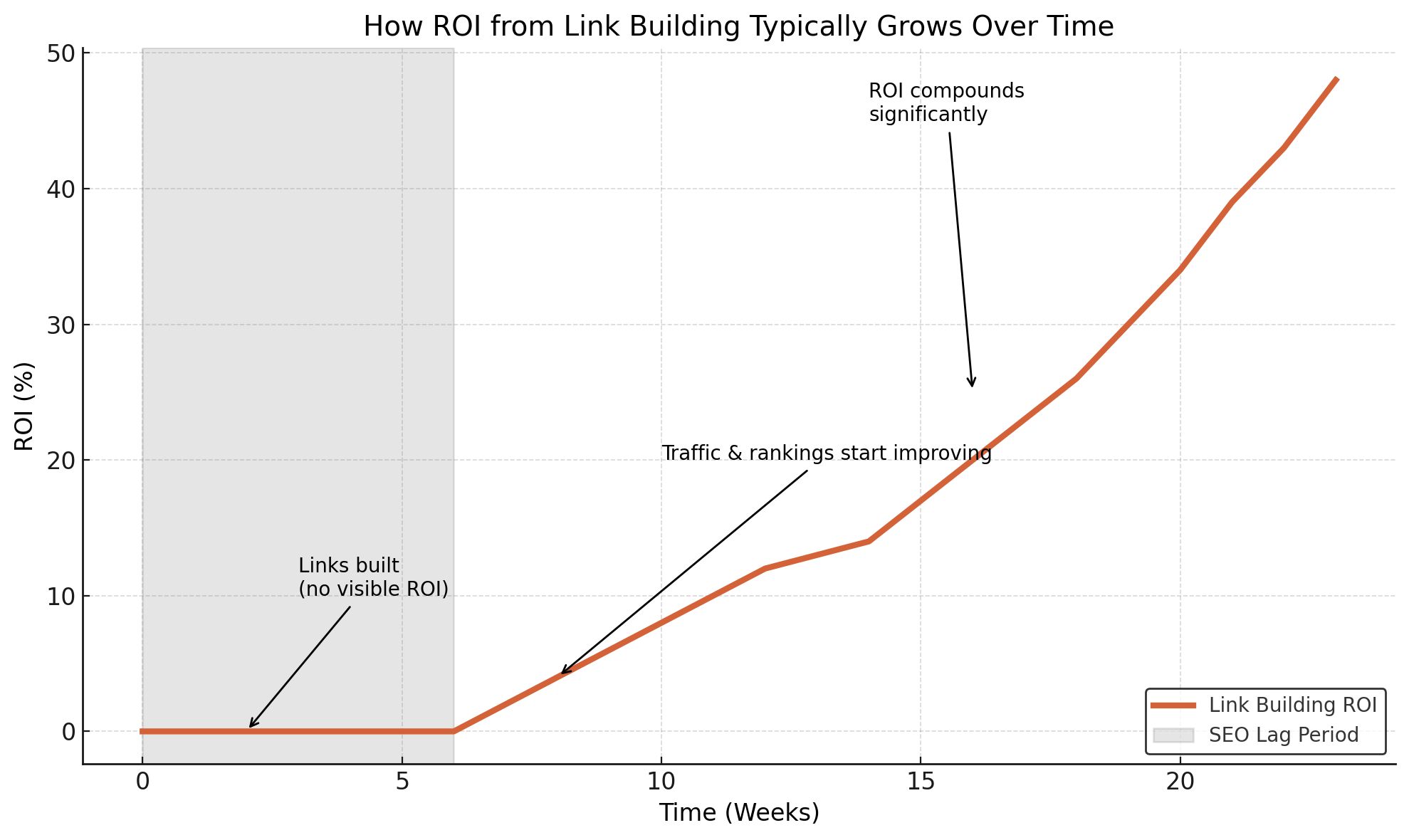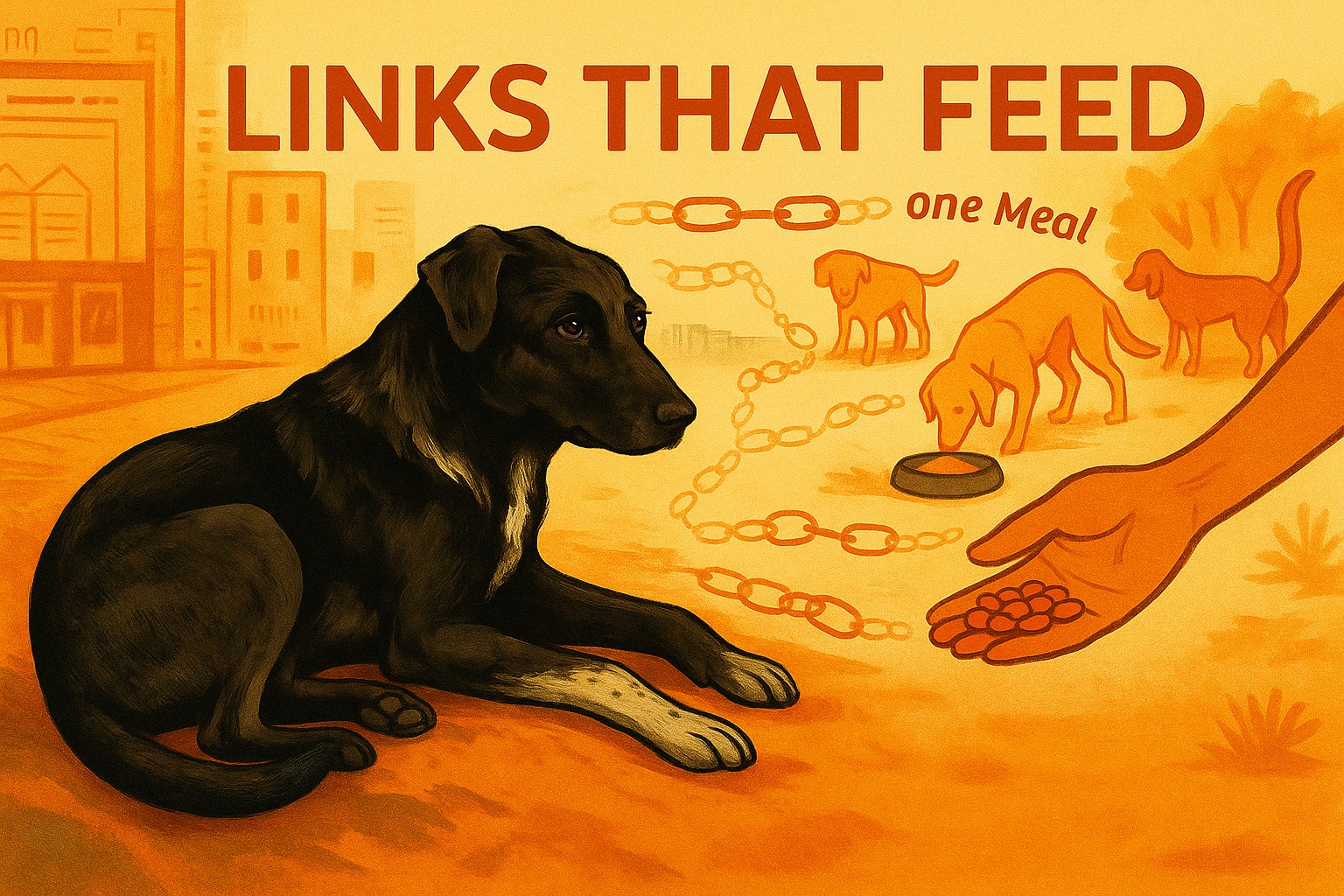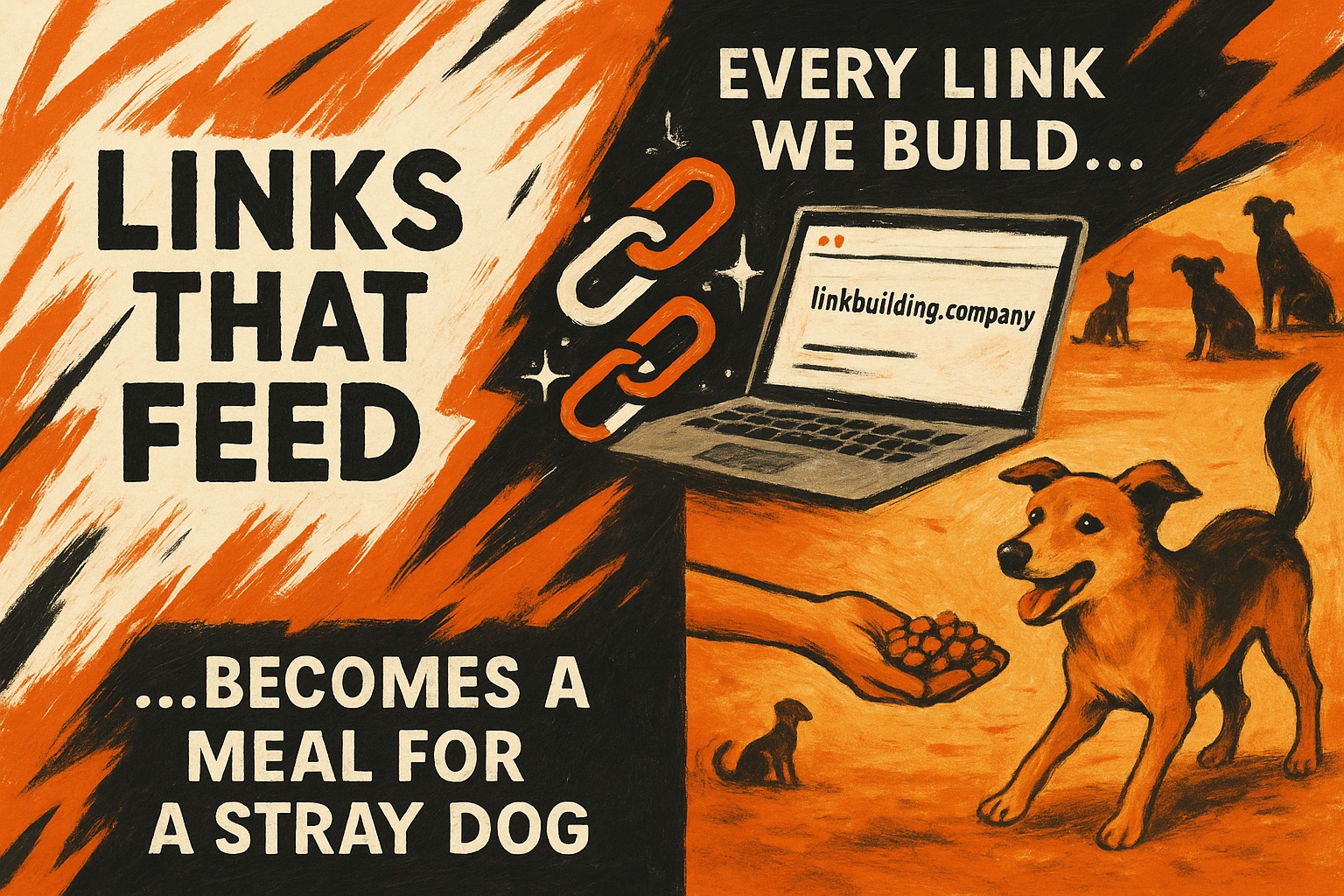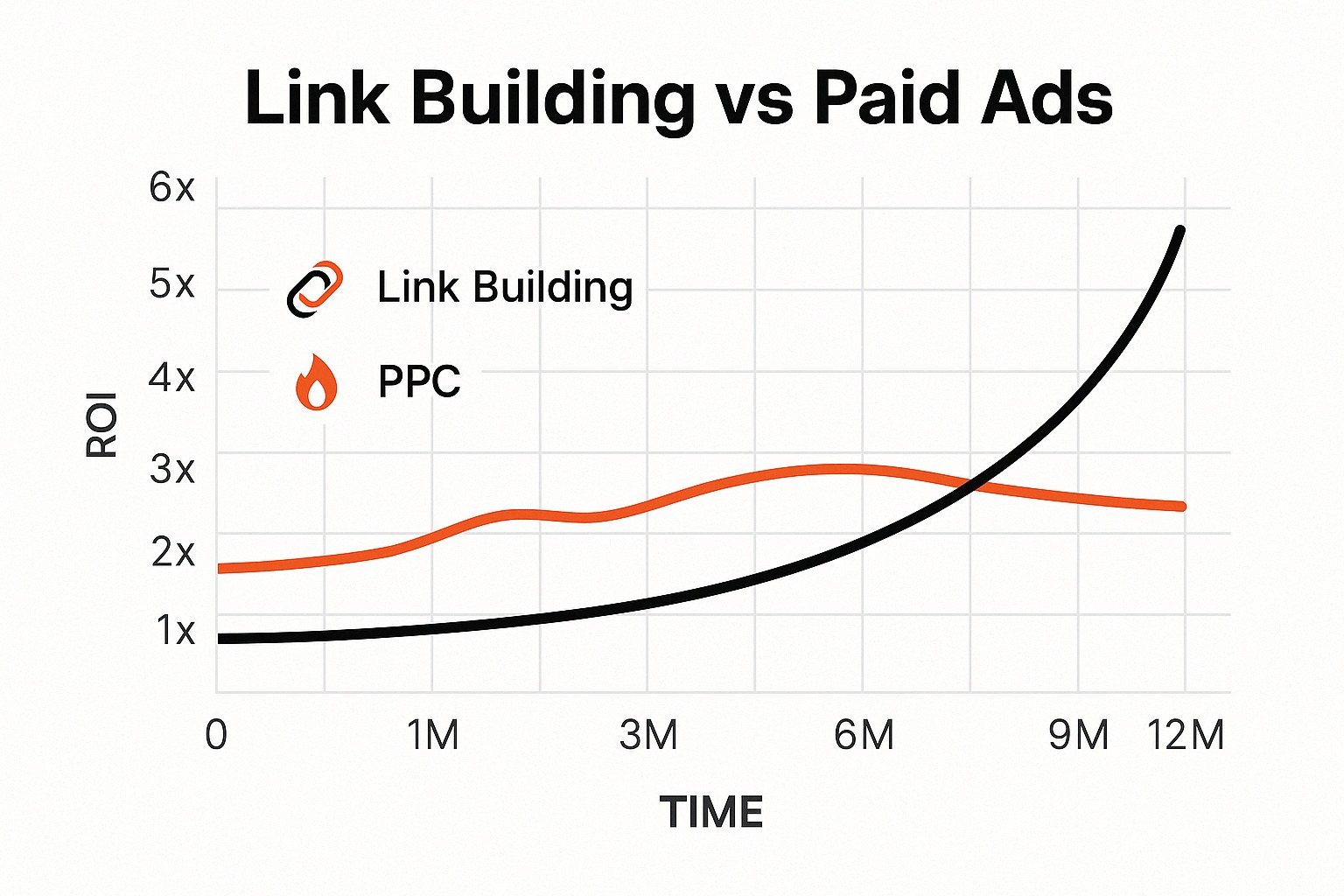If you’re putting money into link building – whether through a link building agency, freelancers, or in-house resources – you’ve probably wondered at some point: Are we actually getting anything back from this?
It’s a fair question. For many businesses, link building can be one of the most time-consuming and expensive parts of SEO. But unlike paid advertising, which gives you quick results and equally quick drop-offs, the benefits of link building compound over time. That’s also what makes it tricky to measure.
This guide is here to help you cut through the noise. We’ll break down exactly what goes into a link building investment, how to track what you’re getting in return, and how to prove – month after month – that it’s worth the spend. Whether you’re running an ecommerce store, a SaaS company, a B2B consultancy, or a local service business, this framework applies to you.
Let’s start with the foundation: what you’re actually investing in when you build links.
What Goes Into a Link Building Investment?
Link building is often misunderstood. It’s not just about getting a link on someone’s blog or paying for a placement on a high-DR site. There’s a lot more going on behind the scenes, and every part of the process carries a cost – whether it’s time, tools, content, or people.
Here’s a quick look at what typically goes into a link building campaign:
- Prospecting and outreach tools: You’ll need platforms like Ahrefs, BuzzStream, or Apollo to find the right websites, pull contact info, and track outreach.
- Time spent pitching: This includes researching websites, crafting personalized emails, following up, and managing replies. If you’ve done any cold outreach, you know it’s rarely a one-and-done task.
- Content creation: Some websites require you to provide content for the link, like a guest post or a resource contribution. That means writing, editing, approvals – and often looping in your SEO or product team.
- Project management and coordination: Even a small link building campaign can involve multiple people: writers, SEOs, designers, outreach specialists, and marketing leads. Someone needs to manage the workflow and keep everything moving.
- Agency or freelancer costs: If you’re outsourcing link building (and many businesses do), you’re paying for all of the above in a bundled fee. That fee might include strategy, content, outreach, and reporting.
- Technical and on-page support: Links won’t do much if they point to slow, poorly optimized, or irrelevant pages. So part of your investment might also include updating your landing pages, fixing site errors, or improving internal links to pass value.
Put simply: you’re not just buying a backlink. You’re funding a mix of strategy, content, and execution that, if done right, can drive serious long-term growth.
When Can You Start Measuring Link Building ROI?
Here’s the uncomfortable truth most SEO agencies won’t say up front: you can’t accurately measure the ROI of link building overnight.
Unlike paid ads where results are almost immediate, link building takes time to show results – especially if you’re targeting competitive keywords or building links to content that still needs to climb the SERPs. That’s not a bug; it’s just how organic search works.
So… when is it actually fair to start measuring ROI?
In most cases, you’ll need to wait at least 3 to 6 months before you start seeing measurable business outcomes from your link building efforts.

- Google crawling and indexing the new link
- The linked page climbing in rankings
- Organic traffic gradually increasing
- Traffic converting into leads, sales, or signups
It’s tempting to panic if you don’t see results after the first month or two – but pulling the plug early is one of the biggest mistakes businesses make. That’s like planting seeds on Monday and expecting to harvest crops by Friday.
The danger of under-investing too early
If you build a few links, see no traction after 60 days, and conclude “link building doesn’t work,” you’re cutting off a potential growth channel before it had a chance to get going. Worse, you’ve wasted that early investment without giving it time to mature.
Instead, treat link building like a medium-term growth bet. Set a 6-month validation window. Commit to consistent activity. Then, assess the results using a clear framework – like the one we’ll walk through in the next section.
A Quick Note on “Results”
Not all link building ROI shows up as immediate conversions. In many cases, you’ll first notice indirect signals that your strategy is working:
- A jump in organic sessions to a key page
- A blog post moving from page 3 to page 1
- Improved keyword diversity or topical authority
- Increased referral traffic from a high-traffic placement
These early wins are strong indicators that your link building is headed in the right direction — even if leads or sales haven’t landed yet.
How to Measure Link Building ROI in 5 Clear Steps
You’ve put in the effort (and budget) to build links – now it’s time to figure out what you’re getting back. This is where most businesses either overcomplicate things or skip the process entirely. But measuring ROI doesn’t need to be a mystery.
Here’s a straightforward, five-step approach that works whether you’re running a small local business, an ecommerce brand, or managing SEO for a national company.
Step 1: Define What ROI Means for Your Business
Before crunching any numbers, get clear on what success actually looks like.
- If you’re a local business, maybe it’s more phone calls or form fills.
- If you run an ecommerce site, it’s likely to be revenue or orders from organic traffic.
- If you’re in B2B, maybe it’s qualified leads or demo requests.
Not every link will lead directly to a sale – but it should move the needle in some way. Define what that looks like upfront so you’re not just tracking vanity metrics like Domain Rating or “number of links.”
Ask yourself:
- Are we trying to increase rankings for a key product or service page?
- Do we want more traffic to a specific blog or resource?
- Are we measuring assisted conversions or last-click?
Once you know what you’re measuring for, everything else becomes easier.
Step 2: Estimate the Value of a Conversion
Let’s say someone lands on your site from organic search. What’s that worth to you?
- For ecommerce: Look at your average order value (AOV)
- For lead-gen: Use your lead-to-sale conversion rate × average deal size
- For SaaS: Estimate value based on LTV (lifetime value) or ARPU (average revenue per user)
For example, if 10 leads generate 1 customer worth £2,000, each lead is worth around £200.
Having even a rough sense of conversion value is key – because otherwise you’re just guessing whether your traffic is valuable.
Step 3: Track the Full Cost of Link Building
Next, calculate what you’re actually spending on link building each month. That includes:
- In-house time (writers, SEOs, outreach team)
- Agency or freelancer costs
- Content creation (guest posts, landing pages, supporting blog content)
- Tools like Ahrefs, SEMrush, BuzzStream
- Design or dev support (if you’re building link-worthy assets)
If someone on your team spends 10 hours/month on link building and their hourly rate is $40, that’s $400/month in labor cost – don’t forget to include that.
Total it up so you have a monthly cost baseline. You’ll compare this to the business impact generated from your links.
Step 4: Attribute Results to Links (with a Time Lag)
Now we get into the fun part – measuring outcomes.
Start by tracking:
- Pages you built links to
- Keyword rankings before and after
- Organic sessions (pre- and post-link)
- Conversions, leads, or revenue from those pages
- Referral traffic from the linking domains
Important: Don’t expect results the same week a link goes live. Give it 2–3 months minimum to account for Google’s indexing, rankings to shift, and traffic to respond. For this reason, many teams track link performance with a 3-month delay between cost and result.
If a blog post received 5 high-quality links in January and saw a 40% traffic bump by April, that growth is likely connected.
You don’t need perfect attribution – directional data is still valuable. Focus on trends, not perfection.
Step 5: Calculate Your ROI
Now it’s time to pull it all together.
Here’s a basic formula:
ROI = (Value Generated – Cost of Links) / Cost of Links
Let’s say:
- You spent $2,000 on link building in January
- By April, those linked pages generated $5,500 in value (via traffic, leads, or direct sales)
Your ROI = ($5,500 – $2,000) / $2,000 = 1.75x ROI
That’s a solid return – and more importantly, it gives you a benchmark to evaluate future investment. If a campaign performs below expectations, you can ask:
- Did we build the right kind of links?
- Were the target pages strong enough?
- Did we invest enough to move the needle?
Tracking ROI over time helps you optimize, not just report.
Real-World Examples of Link Building ROI
Let’s look at how this process works in practice – because the impact of link building varies depending on your business model, goals, and the pages you’re promoting. Below are a few common use cases across different industries, with simplified numbers to illustrate what ROI can actually look like.
1. Ecommerce: Boosting Product Page Rankings
Scenario:
An online home decor brand builds 12 high-authority links to a best-selling product page for “handmade ceramic vases.”
Before link building:
- The page ranked in position 11 for its main keyword
- It received ~300 organic sessions/month
- Converted at 2% with a $70 average order value (AOV)
After 3 months:
- Page climbs to position 4
- Organic traffic increases to ~1,200 sessions/month
- Same conversion rate, same AOV
Results:
- Revenue before: 6 orders/month × $70 = $420
- Revenue after: 24 orders/month × $70 = $1,680
- Monthly revenue lift: $1,260
Link building cost: $2,400
Payback time: Just under 2 months
ROI after 3 months: ~1.6x and growing
2. B2B Lead Gen: Supporting Long-Tail Blog Content
Scenario:
A B2B CRM provider creates a long-form blog post targeting “how to choose the right CRM for small businesses.” They build 5 high-quality contextual links to the post from relevant SaaS and marketing sites.
Before link building:
- Blog ranks around position 18
- Receives 50 organic visits/month
- Drives 1 lead every two months
After 3 months:
- Blog ranks in position 5
- Traffic increases to 400 visits/month
- Now generates 4–5 leads/month
- Historical lead-to-customer rate: 20%
- Average deal value: $1,200
Results:
- New monthly revenue: 1 new customer/month × $1,200 = $1,200
- Link building cost: $1,250
- ROI: ($1,200 – $1,250) / $1,250 = nearly breakeven in month 1, profitable moving forward
Plus, the post continues to rank, drive leads, and build authority over time.
3. Local Services: Increasing Visibility and Calls
Scenario:
A plumbing company in Manchester builds links to its “emergency plumber” service page from local directories, home improvement blogs, and community sites.
Before link building:
- The service page ranks #7 in local search
- It drives 80 organic visits/month
- Generates about 5 calls/month
After 2 months:
- Rises to position 2 for “emergency plumber Manchester”
- Traffic increases to 220 visits/month
- Calls increase to 18/month
- Average job value: £150
Results:
- New monthly revenue: ~13 additional calls × £150 = £1,950
- Link building cost: £900
- ROI: (£1,950 – £900) / £900 = 2.16x ROI
Also worth noting: the improved local visibility boosted Google Business Profile interactions, bringing in more discovery searches.
The Takeaway
Link building doesn’t always lead to immediate conversions. But when targeted properly – toward the right pages, with enough consistency – it can deliver meaningful business impact. And unlike paid ads, links keep working for you month after month.
The key is tracking everything:
- Costs
- Target URLs
- Traffic shifts
- Keyword movements
- Conversions or revenue
Once you have the full picture, you can make smarter, data-backed decisions about how much to invest – and where.
Common Challenges When Measuring Link Building ROI (and How to Overcome Them)
Link building is one of the most powerful parts of SEO – but it’s also one of the trickiest to measure. If you’ve ever felt like you’re doing the work but struggling to connect it to results, you’re not alone.
Here are three of the most common obstacles businesses face when tracking ROI – and how to solve them.
1. Attribution Is Messy
Most customers don’t follow a neat, linear path to conversion. They might discover your site via a blog post, come back weeks later through a branded search, and only then convert through a product page. So when you build a link to that blog post – how do you measure its impact?
How to fix it:
- Track performance at the page level, not just channel level. Look at traffic, rankings, and assisted conversions for the exact URLs you built links to.
- Use Google Analytics 4 to track “first visit source” or assisted conversions if possible.
- Accept that not all ROI will be perfectly trackable. Look for directional gains like traffic spikes, SERP improvements, or keyword growth on linked pages.
2. Not All Links Are Equal
A common mistake: measuring link building success by volume, not value. Ten links from low-quality, irrelevant directories won’t do much. One contextual link from a high-authority, relevant site can outperform them all.
How to fix it:
- Focus on relevance, authority, and context when evaluating links.
- Track the performance of links over time, not just DR scores upfront.
- Use a weighted scoring system if helpful (e.g. links from DR 60+ with 1K+ traffic = “Tier A”; low-traffic guest posts = “Tier C”).
It’s better to track ROI from a few strong links than to average out across a mix of high and low quality.
3. Isolating Link Building from Other SEO Activities
Link building doesn’t work in isolation. If the page you’re linking to is slow, poorly written, or not aligned with search intent, even the best links won’t save it. Similarly, if your site has major technical issues, Google may not give full weight to your backlinks.
How to fix it:
- Build links to pages that are already optimized (or optimize them first).
- Treat link building as one part of a holistic SEO strategy: it works best alongside technical SEO, content, and on-page improvements.
- If you’re measuring ROI, measure it at the channel level first (all organic growth linked to SEO and link building combined), and then start narrowing down to link-specific performance once you’ve got a solid data foundation.
Bonus: Presenting the Data Internally
Even if you’ve done a great job tracking ROI, you may still struggle to communicate that value to leadership – especially if they’re not familiar with how SEO works.
How to fix it:
- Avoid jargon like “DR,” “nofollow,” or “anchor distribution” in reporting. Focus on outcomes.
- Visualize before/after charts: traffic, conversions, keyword positions.
- Tie results to business goals: “This $2,000 investment in link building helped generate $6,000 in new sales this quarter.”
The easier you make it for decision-makers to connect the dots, the more buy-in you’ll get to continue or scale your efforts.
Link Building vs. Paid Ads: Which Delivers Better ROI?
One of the biggest questions marketing teams ask – especially when budgets are tight – is whether to invest in SEO and link building or to double down on paid ads like Google Ads, Meta, or LinkedIn.
The answer isn’t always black and white. Both channels have their place, and both can generate results. But they behave very differently when it comes to how and when you see ROI.
1. Link Building: Long-Term ROI, Compounding Gains
Link building takes longer to show results, but once it starts working, it can drive growth for years – without paying for every click.
What you get:
- Long-term rankings that bring in traffic month after month
- Compounding authority across your domain
- Increased visibility for high-converting pages
- Improved performance across all organic content
What it requires:
- Upfront investment
- Patience (typically 3–6 months for results)
- A good content and technical SEO foundation
If you’re playing the long game and want to build a sustainable, cost-efficient acquisition channel, link building is hard to beat.
2. Paid Ads (PPC): Fast Wins, But Temporary
Paid advertising works fast. Within days, you can start getting clicks, leads, and sales – making it ideal for product launches, seasonal campaigns, or hitting aggressive short-term goals.
What you get:
- Immediate traffic and visibility
- Granular targeting and testing
- Predictable cost per click
But…
- As soon as you stop paying, the traffic disappears
- Costs tend to rise over time, especially in competitive niches
- You’re renting attention, not building equity
PPC works well if your business needs quick wins or if you’re validating a new product or market. But it’s not a substitute for long-term organic visibility.
So… Which One Wins?
It’s not about one being better – it’s about understanding timing and return:
| Factor | Link Building | Paid Ads |
|---|---|---|
| Time to ROI | 3–6 months | 1–7 days |
| Traffic growth | Compounding | Immediate but stops without spend |
| Cost control | Fixed (by link cost) | Variable (per click/lead) |
| Brand equity | Builds over time | None (rented visibility) |
| Ideal for | Long-term growth | Quick lead generation, testing |
In a perfect world, businesses should use both – PPC to drive immediate results, and link building to build a long-term engine that lowers your cost per acquisition over time.
But if you’re choosing between the two, ask yourself:
- Do I need leads this month, or am I building a long-term funnel?
- Can I afford a 3-month wait for sustainable growth?
- Am I happy to keep paying for every click forever?
If your goal is profitability and growth that lasts, link building should absolutely be part of your strategy.
How Much Should You Invest in Link Building?
One of the most common questions we hear from clients – whether they’re running a local business, ecommerce store, or national B2B brand – is:
“How much should we be spending on link building each month?”
The short answer? It depends.
The longer, more helpful answer? It depends on your goals, your industry’s competitiveness, and the current state of your website.
Here’s how to think about it.
Start with the Cost of a Quality Link
A good-quality backlink – one that’s relevant, placed on a real site with traffic, and earned ethically – typically costs anywhere from $150 to $500+ when you factor in:
- Prospecting and outreach time
- Content creation or guest posting
- Negotiation, editing, and follow-up
- Project management and reporting
Sure, you can get links cheaper – but lower-cost links often come with trade-offs like:
- Irrelevant or spammy domains
- No traffic
- “Link farm” footprints that can hurt long-term trust
So before you set a budget, ask yourself: Are we aiming for quality or just hitting a quota?
Benchmarks by Business Size and Type
Here are rough monthly benchmarks based on different business profiles:
| Business Type / Size | Recommended Monthly Investment |
|---|---|
| Local business | $500 – $1,500 |
| Small ecommerce store | $1,500 – $3,000 |
| Mid-sized brand or B2B | $3,000 – $6,000 |
| National or competitive niche | $6,000 – $15,000+ |
These ranges assume you’re working with a freelancer or agency, or investing internally in a team + tools. If your site already has strong content and good technical SEO, you may lean toward the lower end. If you’re starting from scratch or in a hyper-competitive space, you’ll need more firepower.
How to Know If You’re Spending the Right Amount
Ask yourself a few honest questions:
- Are we seeing traffic and ranking gains within 3–6 months?
- Are the links we’re building actually moving the needle for priority pages?
- Do we have enough budget to build momentum, not just trickle in one link a week?
If your answer is “no” to any of the above, it might be time to increase your investment – or reassess where and how that budget is being spent.
Also, keep in mind: you can’t out-link your way out of weak content or bad UX. The best ROI comes when link building is paired with optimized, high-converting pages.
Track Your Link Building ROI with Our Free Tracker
If there’s one thing that makes link building feel like a “black box,” it’s the lack of consistent tracking. Too often, businesses build links and hope for the best – without connecting the dots between costs and results.
That’s exactly why we put together a Link Building ROI Tracker – a simple, ready-to-use Google Sheet that helps you monitor:
- Which pages you’re building links to
- How much each link (and campaign) costs
- What traffic, keyword, and conversion changes follow
- Your cost per lead, per sale, or per signup
- The ROI over time
It’s designed to be easy to update once a month. No fancy dashboards. Just the numbers that matter, in one place.
Link Building ROI Calculator
Whether you’re reporting to a boss, a client, or just trying to get a better grip on your own strategy, this tool will help you make smarter decisions and get more from every backlink you earn.
Final Thoughts
Link building isn’t cheap. It’s not instant. And it’s definitely not “just for SEO.” Done right, it’s one of the most powerful ways to grow your online visibility, outrank competitors, and generate compounding returns over time.
But if you want those results, you need to treat it like a real investment – and track it like one, too.
Start small if you need to. Build consistently. Focus on quality. Measure honestly. And most importantly, keep pushing forward.
Because in the world of organic growth, the brands who win are the ones who don’t give up after month two.
 Guest Posting
Guest Posting Blogger Outreach
Blogger Outreach Link Insertions
Link Insertions White Label Link Building
White Label Link Building International Link Building
International Link Building Multilingual Link Building
Multilingual Link Building


